The Romans borrowed technology from other civilisations. It enabled them to build aqueducts, amphitheatres, hippodromes and model towns
By Nick Nutter | Updated 8 Mar 2022 | Andalucia | History |
Login to add to YOUR Favourites or Read Later
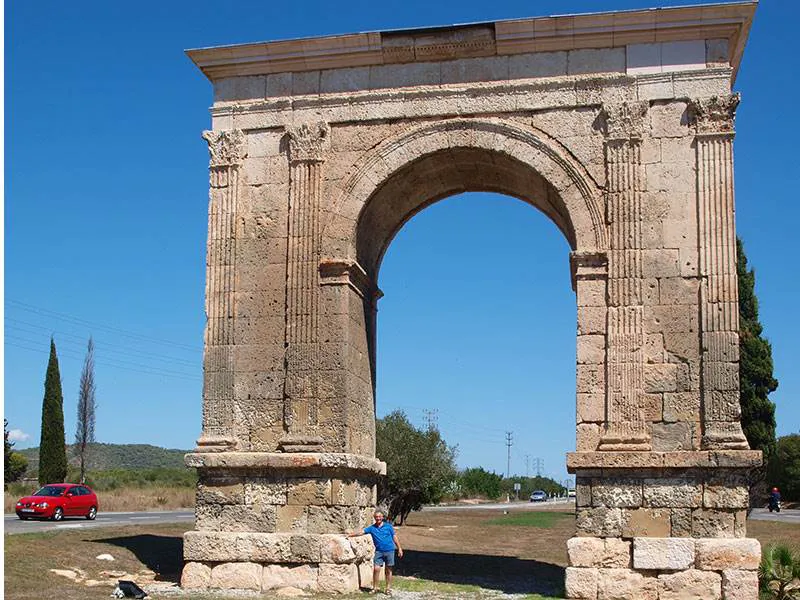
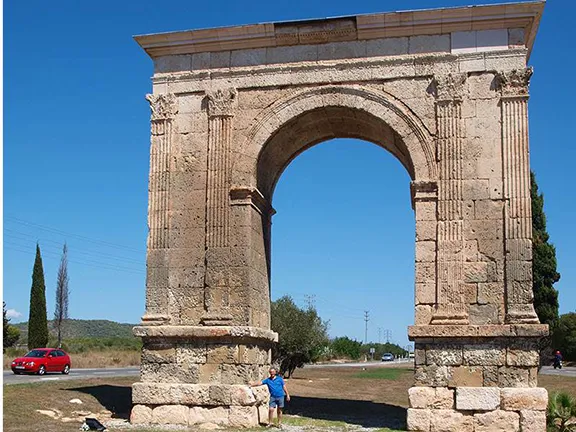
Bera Arch
The Romans were not afraid to use technology borrowed from other civilisations, the Greeks, Egyptions, civilisations from the Middle East, the Phoenicians and the Carthaginians. Their skill came in improving that technology and developing techniques that could be replicated. Everything from a waterproof cement, to arches, to a complete town plan.
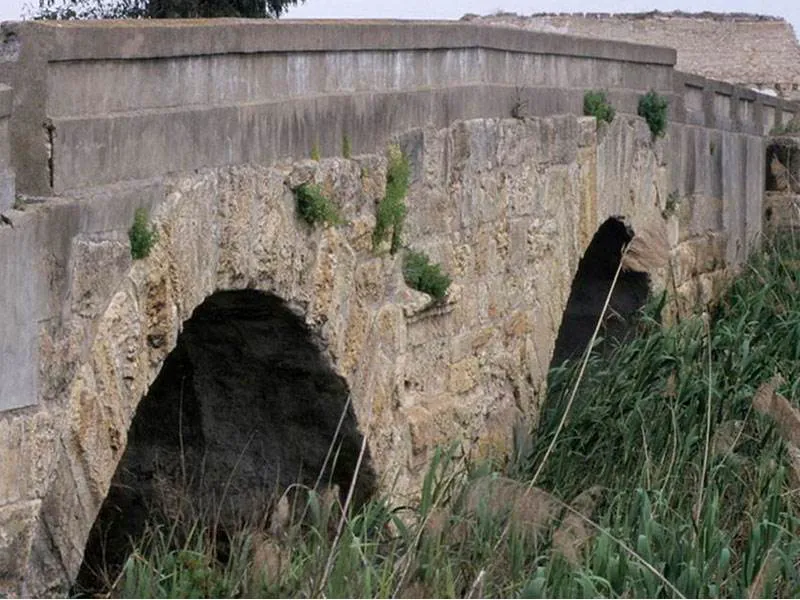
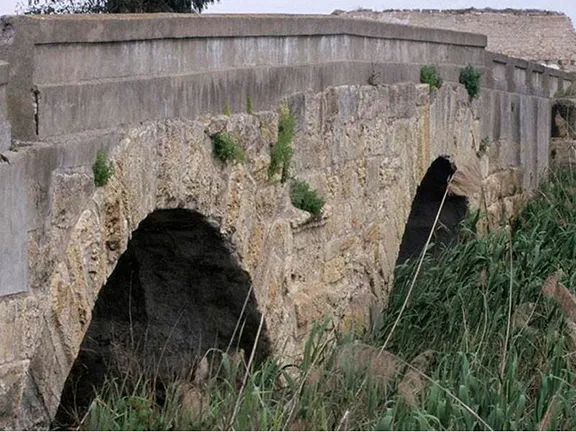
Alcantarilla Bridge
Amphitheatres were round structures usually with subterranean passages, used for gladiatorial contests, displaying wild animals and other spectaculars. Amphitheatres are much more common than hippodromes; there are good examples to be found at Italica and Carmo (Carmona). Carmona was taken from the Carthaginians in 207 BC when it was occupied by Hasdrubal Gisco and Hannibal’s brother, Mago. The Battle of Carmona was one of Scipio’s first major battles in Hispania. The impressive walls surrounding the city and the massive Seville Gate were mentioned by Julius Caesar and are still an outstanding feature. It was during the second half of the 2nd century BC that Carmona became one of the more important cities in Baetica being on the section of the Via Augusta between Hispania (Seville), Asitigitana (Ecija) and Corduba (Cordoba). The remains of the amphitheatre are about 1 kilometre west of the Seville Gate.
Remarkably, given the Roman tolerance and desire to provide the entire citizenry with pleasures, there was one group of people who made such a bad impression that they often made involuntary visits to the amphitheatre where they were put on the menu. It must have taken a lot to push the Romans to such extremes but the members of the new faith, the Christians, managed it. They had diametrically opposing views to the Romans. They, for instance, believed that there was no pleasure meant for this life, that came later, after death, if you proved worthy enough. They believed in one god, which the Romans would have accepted, except the Christians maintained there were no others. The Romans were entirely comfortable with the diverse gods they worshipped. They could not understand how the Christians could know that theirs was the only god since there were vast areas of the world with unknown races and unknown religions
Christians also did not believe in personal hygiene. Contemporary writers repeatedly remark on the nefarious aroma surrounding Christians, their lank, untrimmed hair, their dirty, unrepaired rags. The Romans would probably have managed to cope with all that, by staying upwind and ignoring them, if the Christians had not pushed them too far. They not only preached that their god was a king they tried to convert everybody that they came across. This the Romans could not accept. They had their king emperors, real people, and as far as they were concerned, the Christians were inciting unrest. So they fed them to the lions, tigers and other carnivorous beasts in one last attempt to make the Christians happy. By making them martyrs.
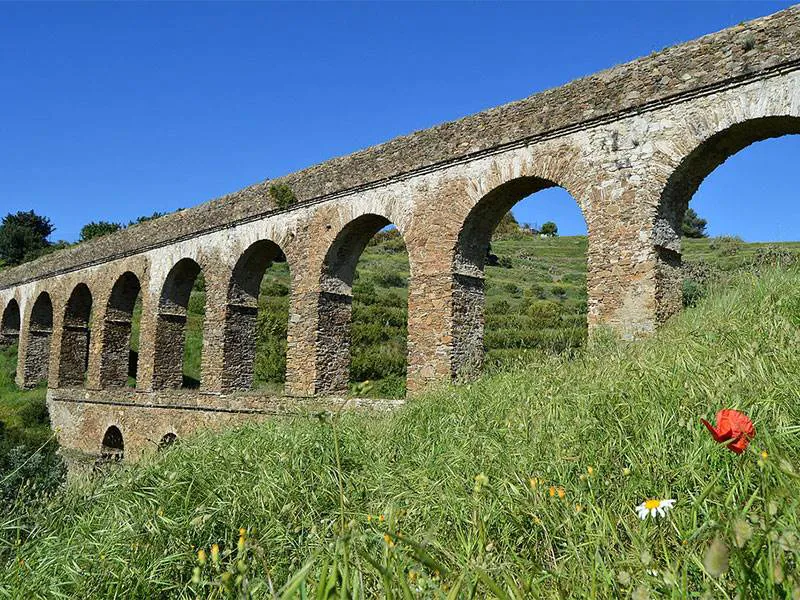
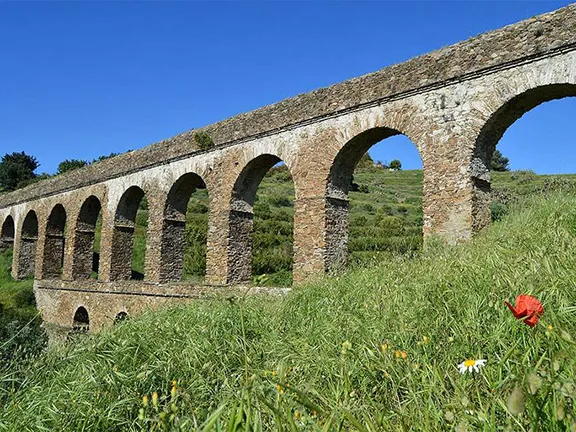
Aqueduct Almunecar
Theatres were semi-circular structures used for plays, poetry readings and concerts. They usually had a wooden stage. There are good examples at Acinipo, Malaka (Malaga), Baelo Claudia and Gadir (Cadiz). The theatre at Urso (Osuna) is now a ruin.
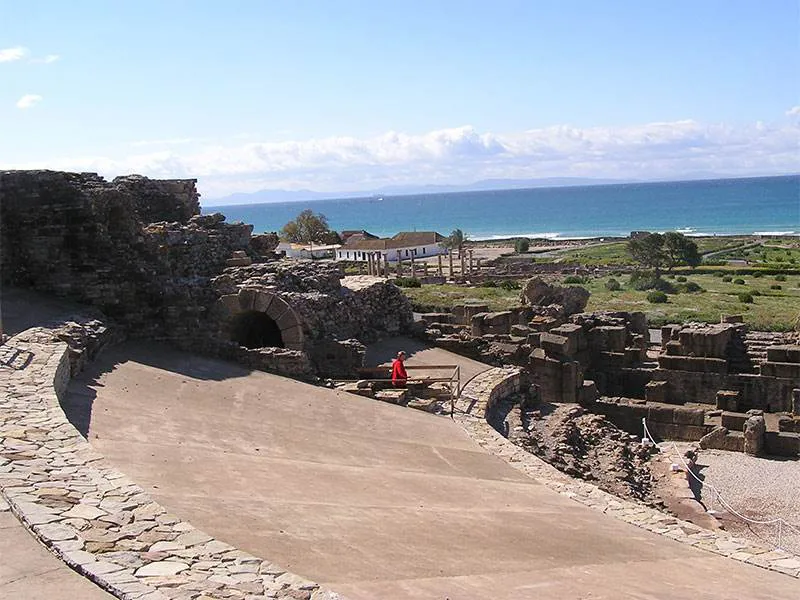
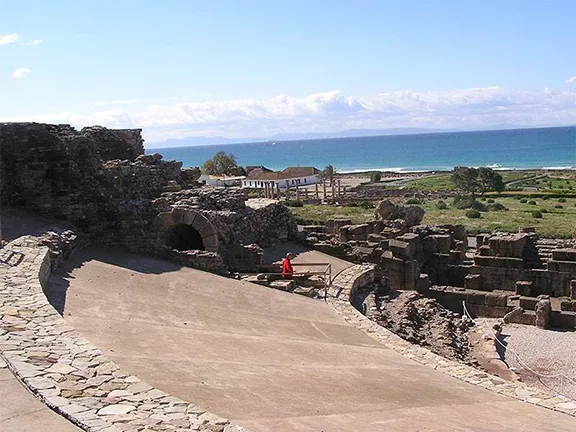
Theatre Baelo Claudia
The Romans excelled as hydraulic engineers. To supply a town with water, they built a network of pipes, channels, and conduits. Roman engineers would survey the land looking for a source of water to supply the town and create a gentle slope between the two, often by following contours. Much of the system was underground, only emerging as monumental aqueducts when it was necessary to cross a valley. Once the route had been determined, tunnels were excavated by hand. Shafts dug at intervals down the route were used to take out the waste and lower stone blocks to line the tunnels. They were fixed in place using opus signinum, a waterproof cement that included crushed tiles and amphorae. Opus signinum is so hard-wearing that many of the original tunnels are still watertight today. The water flow was controlled by using sluice gates and sophisticated bronze valves that would not be out of place in a modern water system.
Whilst we do not have anything as impressive as the aqueduct at Segovia, we do have one splendid example at Almunecar. It was built during the 1st century AD to carry water into the town of Almunecar from the hills to the north. It can be followed from the Rio Seco, through the village of Torrecuevas, to the Rio Verde valley back to Almunecar. The most dramatic view of the aqueduct is in the Rio Verde section.
The most extraordinary feat of hydraulic engineering in Andalucia has to be the 1st century AD aqueduct that carried water 80 kilometres from Tempul to the city of Cadiz. Until 2018 only fragments of this work, claimed to be the most remarkable feat of engineering in Hispania, had been found. A violent storm in March 2018 removed huge quantities of sand from Cortadura beach at Cadiz to reveal an aqueduct. During the Roman period, Cadiz was an island. The stone arches would have traversed part of the Bay of Cadiz. What is incredible is that much of the original opus signinum is still holding the structure together after 2000 years, half of which was spent beneath the surface of the sea.
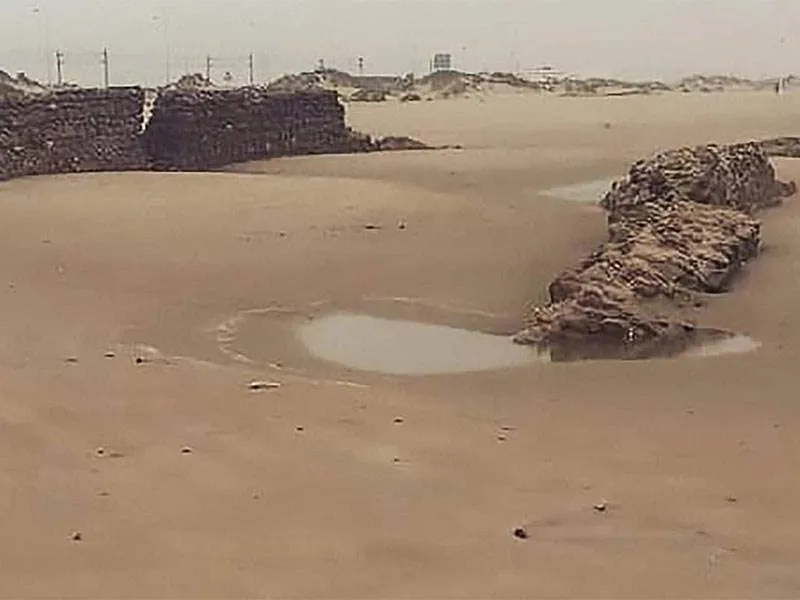
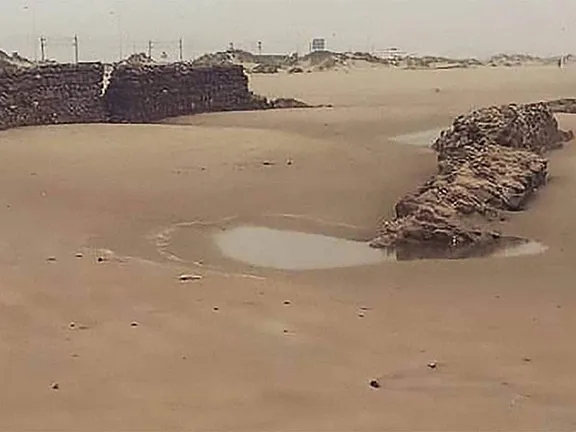
Aqueduct Cortadure beach
As the saying goes, ‘All roads lead to Rome’. This phrase came about due to a man called Ptolemy. He wrote an itinerary, a verbal map, which gave the distances between staging posts and towns throughout the Roman Empire in the 2nd Century AD. Whether by accident or design he called all the roads leading to one area of the Empire by the same name. His itineraries always start in Rome. The road that led out of Rome that would lead to Spain was called the Via Aurelia. It became the Via Iulia at Genoa and then the Via Domitia and finally the Via Augusta at Tarragona.
By the time the Via Augusta reached Cadiz, there had been several road junctions as a result of which there are a few Via Augustas. The main artery ran from Narbo Martius (Narbonne), parallel to the coast to Tarraco (Tarragona), Dertosa (Tortosa) and Saguntum (Sagonte) to a few kilometres north of Carthago Nova (Cartagena). It then went north to Saltigi (Chinchilla de Monte-Aragon) and then west to Libisosa (Lezuza). From there it headed south-west through Mentesa Oretana (Villanueva de la Fuente) in the present-day province of Ciudad Real.
The Via Augusta entered Andalucia near Venta de los Santos on its way to Iliturgi (Mengibar). From there it followed the course of the Baetis to Cordoba, Colonia Augusta Firma Astigi (Ecija), and via Obucla (Fuente de Andalucia) and Carmona to Hispalis (Seville). It then loops round to the south-east to pass through Orippo (Dos Hermanos) to Ugia (Utrera). From there it resumes a southwesterly course to Rotea (Rota), and finally south-east through Portus Gadilanus (El Puerto de Santa Maria) to Cadiz.
Tributary roads were built later from Hispalis to Onuba (Huelva), from Cadiz down the coast to Baelo Claudia and Mellaria (Tariffa) to Carteia (San Roque). By the late Empire period, the main road network in Andalucia eventually linked all the major Roman towns and cities.
The whole network was known by the same name, and it was true they all led, eventually, to Rome. There is one notable exception in Andalucia, the Via de la Plata from Seville north to Santiago de Compostella. It was built by the Romans to bring silver from the mines at Burgos to Seville. It later became a pilgrimage route.
Besides the major roads, there were numerous secondary roads. Some were paved, some not, many of them are in use today such as the track up to the Roman Baths at Manilva and continuing to Casares. These were not mentioned in the itinerary. One of the better sections of paved Roman road, complete with drainage ditches and small bridges over streams, is known as the Sendero Calzada Romana. The Sendero Calzada Romana is now a very pleasant 3.8-kilometre walking trail between The Roman military town of Ocvri (Ubrique), and Benaocaz.
The roads were marked at intervals of one mile by a milestone and periodic intervals by small settlements like Oba (Jimena de la Frontera), and Ubrique, some fortified or protected by a tower such as the one at Carteia. The settlements tended to be about a days march apart. The Via Augusta was named after Emperor Augustus who, between 8 BC and 2 BC ordered the entire 1,500-kilometre length renovated. Before the renovation, the road was called the Via Herculae. The road was initially designated a via militaris, a military road and would have been built by legionaries of the Roman army. It was not until 90 AD that the Via Augusta required further renovation, and that was ordered by Emperor Domitian. A fragment from a milestone found near Cordoba shows that the Via Augusta was still designated a military road.
VIAM AVGVSTAM MILITAREM / VETVSTATE CORRVPTAM RESTITVIT
He (Domitian) restored the via militaris Augusta, which had become dilapidated through old age
Gradually the roads became more important for commercial reasons than military.
In 2018 archaeologists claimed they had found Kilometre 0 of the Via Augusta. After the renovation of the road, Emperor Augustus ordered the building of a triumphal arch to span the road at the Roman city of Iturgi (Mengibar). It was seven metres high, four metres deep and 15 metres wide. Only the foundations remain today, the rest of the arch having been plundered to help build the Mengibar Tower, part of an Arab fortress. Iturgi is 25 kilometres north of Jaen city in the high reaches of the Baetis river. Its position is approximately on the border between Baetica and Tarraconensis and may have marked that division.
Although the Iturgi triumphal arch has disappeared, one similar arch remains in Spain. The Berà arch, 20 kilometres northeast of Tarragona, was built around the same time, is still intact and straddles a section of Roman road. The Berà arch probably marks the end of the Via Domitia and the beginning of the Via Augusta. The present-day N340 becomes, temporarily, a dual carriageway to bypass this impressive monument.
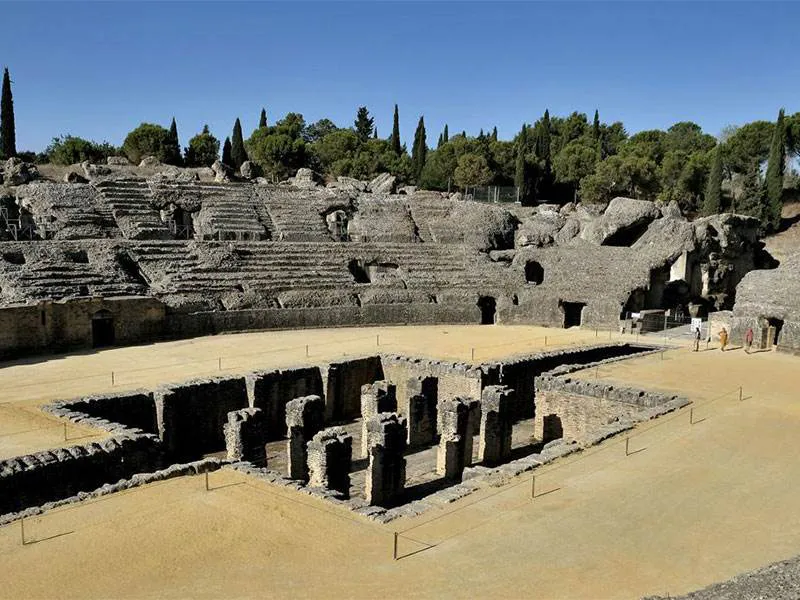
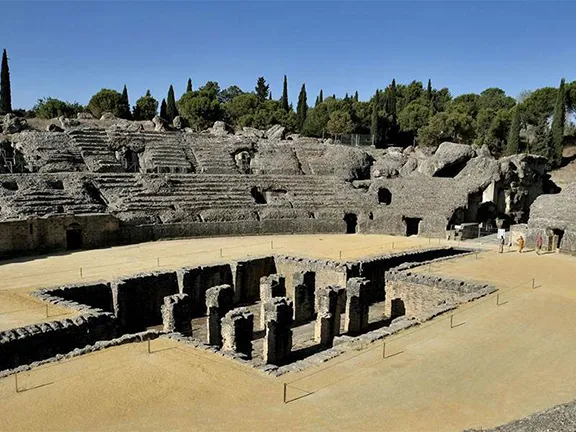
Amphitheatre Italica
Bridges are the most visible reminder of the Roman roads. Whilst the roads tend to have been resurfaced many times the bridges often retain the original architecture albeit with a tarmac surface. Probably the best example in Spain is the bridge at Merida spanning the Rio Guadiana and marking the highest point of navigation on that river during Roman times. It has been repaired several times, but the surface is still paved as it would have been originally.
The most spectacular Roman bridge in Andalucia is that at Cordoba with its massive abutments spanning the Rio Guadalquivir. Again it has been repaired many times. It is now a pedestrian-only bridge with a smooth paved surface. Both lead to imposing gates leading into their respective cities.
The Alcantarilla bridge at Ultrera in Seville province 32 kilometres south of Seville, is a double-arched bridge over the river Salado. On one of the cutwaters on its piling, is an inscription that states the bridge was on the Via Augusta.
A fifteen arch bridge over the Baetis at Isturgi (Andujar in Jaen province) spans the Baetis. Although named the Puente Romano, it may date from a later period.
The Romans liked everything to be organised and orderly. Streets were laid out in neat, straight lines, ar right angles to each other. In the middle of the town there was a large square, called the forum. It was used as a market place and for meetings. It had shops and offices on three sides and government offices on the other side. At one end of the forum was a large building called the basilica. There were temples too where the Roman gods were worshipped. Some towns had public baths, an open-air theatre and huge monumental arches. Many towns had running water and sewers. Aqueducts brought water to the towns.
Only the rich had water piped to their houses; everyone else used water from public fountains. The only toilets were public lavatories, which were built around the town and connected to underground sewers.
Throughout their empire the Romans built towns in exactly the same style. They were designed in the form of a grid, with streets built at right angles to each other and parallel with one of the two main roads. One road ran north - south, the Cordo Maximus, and the other, the Decumanus Maximus, east - west. At the point where these roads met was the town centre, where the administrative centre and the forum were found.
The streets of Roman towns were between five and eight metres wide. Their width depended upon their importance.
The central part of the town contained the main businesses, with the homes and dwellings of the citizens further towards the edges of the town. The cemetery was always outside the town walls.
Buildings were made of stone and brick. They were so well built that large portions of many Roman buildings and even towns, still exist 2000 years after they were built.
Baelo Claudia, on the Atlantic coast near Bolonia in Cádiz province, was founded at the end of the 2nd century BC. The remains are the most comprehensive example of a Roman town in the whole of the Iberian peninsula. It reached its peak between 41 and 45 AD when Emperor Claudius ordered the building of much of the monumental complex. Baelo Claudia was granted the status of municipum.
Roman villas were large country houses, built around a central square courtyard. They are usually one or tow floors, with red, tiled roofs. Some of the larger villas would have had their own bath houses and underfloor heating. All the rooms would have mosaic floors and richly decorated walls. A few villas would have been built within the towns, for the most important town officials, but most were in the countryside.
There were two types of rural villa, the villa urbana and the villa rustica. The villa urbana was a sort of country seat, easily reached from a major town or city whilst the villa rustica was permanenetly occupied by servants who ran the estate attached to the villa. The villa rustica had luxurious accommodation for the owners who only spent part of their time on the estate.
The villa rustica also had accommodation for the estate workers, store rooms, stalls for animals, workshops and, in some cases, a punishment room or prison. The owner’s accommodation is referred to as ‘Pars urbana’ whilst the farming area is called ‘Pars rustica’.
The villa rustica was operated as a farm is today. It may specialise in one or two products, olives or grapes for instance, and be mainly self sufficient in other essentials, fruit, vegetables and meat. Surplus produce would be sold at the nearest market.
The Finca del Secretario, at Fuengirola, was a coastal villa rustica. Its speciality was salted fish and garum that was transported to the market at the coastal village of Suel. Part of the villa complex included a series of kilns for baking the amphorae in which the fish and sauce were transported.
Sometimes hailed as the best preserved villa rustica in the Iberian peninsula, the Villa Romana El Ruedo, at Almedinilla in Cordoba province dates from the 1st to the 7th century AD. The owner had lavish accommodation and many of the sculptures found at the site are in the local museum. There is also an extensive farming area to visit, the Pars rustica.